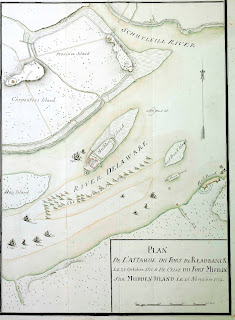One artifact collection recently submitted to the State Museum of PA involved an underwater survey of a small portion the Delaware River in anticipation of a runway expansion at the Philadelphia International Airport. Ground penetrating radar and sonar surveys were used to identify areas of interest or “targets” that were later visually inspected with the aid of SCUBA gear. Seen below is a sample of artifacts recovered from the underwater excavation.
earthenware ceramic sherds, dark green glass wine bottle fragment, iron spike, and stoneware bottle c. mid 19th C.
In his manuscript A Preliminary Survey to Analyze the Potential Presence of Submerged Cultural Resources in the Delaware and Susquehanna Rivers J. Lee Cox Jr. lists over 100 shipwrecks on the Delaware River between 1757 and 1946. Schooners, sloops, tugs and steamers, with names like Mosquito, Yankee Doodle and Sturdy Beggar, succumb to watery graves from collisions with other vessels, boiler explosions, deck fires and crushing winter ice.
1777 Map of Delaware River
Moving to the opposite corner of the State, this Snead shallow water diving helmet was recovered off of Presque Isle in Lake Erie, and was donated to the State Museum of PA by John Cutter in 2005. Cast iron in construction, weighing around 60 lbs it dates between 1900 and 1940 and is truly a one of a kind object in the collections of the Section of Archaeology. Not known to be associated with any shipwreck, the helmet is currently on loan to the Erie Maritime Museum.
Snead shallow water diving helmet 1900 - 1940
Reference:
Cox, Jr., J. Lee
A Preliminary Survey to Analyze the Potential Presence of Submerged Cultural Resources in the Delaware and Susquehanna Rivers (1984)
unpublished manuscript on file State Museum of PA, Section of Archaeology
For more information, visit PAarchaeology.state.pa.us or the Hall of Anthropology and Archaeology at The State Museum of Pennsylvania .



Hello and Happy Holidays. Has any work been done to locate the revolutionary war wrecks in the Delaware River off Ft. Mifflin and Ft. Mercer? There should be some numbers of Continental, Pennsylvania State, and British ship wrecks in that general area as well as individual cannons that had been dumped into the river. Are there any sources you can point me to? Thanks.
ReplyDelete